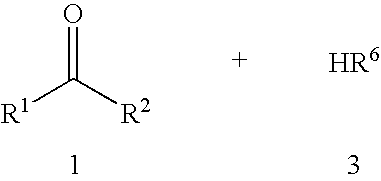Method for catalyzing amidation reactions
a technology of amidation reaction and reaction method, which is applied in the preparation of carboxylic acid amides, organic chemistry, chemistry apparatus and processes, etc., can solve the problems of unexpected and disadvantageous slowness of amidation reactions
- Summary
- Abstract
- Description
- Claims
- Application Information
AI Technical Summary
Benefits of technology
Problems solved by technology
Method used
Image
Examples
examples 1-10
The imidazolides shown in Table 1 were prepared from the corresponding carboxylic acids by reaction with N,N′-carbonyldiimidazole. The resulting imidazolide was reacted with the amine shown in Table 1 both with and without the presence of added carbon dioxide. A typical procedure was as follows. A mixture of the carboxylic acid (6 mmol) and N,N′-carbonyldiimidazole (CDI) (7.2 mmol) in tetrahydrofuran (THF) (20 mL) was stirred at 45° C. When HPLC indicated complete conversion to the imidazolide, the mixture was concentrated to dryness in vacuo to remove all CO2. This mixture containing the imidazolide and imidazole was diluted with 10 mL THF. In a separate flask, CO2 was bubbled through a solution of the amine (7.8 mmol, 1.3 equiv) in THF (10 mL) for 15 min. This solution was added to the solution of the imidazolide and imidazole, and stirred at 45° C. The reaction was monitored by HPLC. For the uncatalyzed reactions, a solution of the amine in 10 mL THF was added to a solution of t...
example 11
N-Benzyl-5-formyl-2,4-di methyl-1H-pyrrole-3-carboxamide
Hydroxybenzotriazole (0.49 g), 1-(3-dimethylaminopropyl)-3-ethylcarbodiimide hydrochloride (7.45 g), triethylamine (5.74 g), benzyl amine (3.20 g) and acetonitrile (30 mL) were added to 500 mL 3-neck round-bottomed flask. The resulting solution was stirred vigorously while 5-formyl-2,4-dimethyl-1H-pyrrole-3-carboxylic acid (5.00 g) in acetonitrile (20 mL) was added to it. The mixture was stirred at room temperature under an atmosphere of N2 for three hours. After this time, the mixture was diluted with water, brine, saturated NaHCO3, and the pH adjusted to >10 with 50% NaOH solution. The aqueous mixture was then extracted with a 90% CH2Cl2 / MeOH (2×250 mL) solution. The organics were dried over sodium sulfate and concentrated giving light orange solids, which were collected by suction filtration and washed with cold acetonitrile. The product was isolated as an off white solid (1.45 g) in 21% yield. 1H NMR (DMSO-d6) δ 11.85 (...
example 12
N-Benzyl-2,4-dimethyl-1H-pyrrole-3-carboxamide
Hydroxybenzotriazole (0.35 g), 1-(3-dimethylaminopropyl)-3-ethylcarbodiimide hydrochloride (5.37 g), triethylamine (4.14 g), benzyl amine (2.31 g), and acetonitrile (20 mL) were added to 250 mL 3-neck round-bottomed flask. The resulting solution was stirred vigorously while 2,4-dimethyl-1H-pyrrole-3-carboxylic acid (3.00 g) in acetonitrile (20 mL) was added to it. The mixture was stirred at room temperature under an atmosphere of N2 for three hours. After this time, the mixture was diluted with water, brine, saturated NaHCO3, and the pH adjusted to >10 with 50% NaOH solution. The aqueous mixture was then extracted with 90% CH2Cl2 / MeOH (2×250 mL). The organics were dried over sodium sulfate and concentrated in vacuo yielding a yellow oil. The crude material was chromatographed (SiO2; 1% methanol / methylene chloride) to afford 2.05 g (42%) of the product as white crystals. 1H NMR (DMSO-d6) δ 10.53 (s, 1H), 7.54 (t, J=6.1 Hz, 1H), 7.33-7...
PUM
| Property | Measurement | Unit |
|---|---|---|
| Fraction | aaaaa | aaaaa |
| Fraction | aaaaa | aaaaa |
| Fraction | aaaaa | aaaaa |
Abstract
Description
Claims
Application Information
 Login to View More
Login to View More - Generate Ideas
- Intellectual Property
- Life Sciences
- Materials
- Tech Scout
- Unparalleled Data Quality
- Higher Quality Content
- 60% Fewer Hallucinations
Browse by: Latest US Patents, China's latest patents, Technical Efficacy Thesaurus, Application Domain, Technology Topic, Popular Technical Reports.
© 2025 PatSnap. All rights reserved.Legal|Privacy policy|Modern Slavery Act Transparency Statement|Sitemap|About US| Contact US: help@patsnap.com



